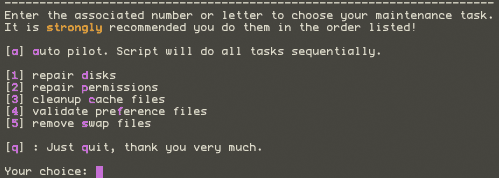Introduction
CURRENT PROJECT VERSION: 1.7b1
AppleJack is a user friendly troubleshooting assistant for Mac OS X. With AppleJack you can troubleshoot a computer even if you can't load the GUI, or don't have a startup CD handy. AppleJack runs in Single User Mode and is menu-based for ease of use.

Using AppleJack, you can repair your disk, repair permissions, validate the system's preference files, and get rid of possibly corrupted cache files. In most cases, these operations can help get your machine back on track. The important thing is that you don't need another startup disk with you. All you need to do is restart in Single User Mode (SUM), by holding down the command and s keys at startup, and then typing applejack, or applejack auto (which will run through all the tasks automatically), or applejack auto restart (which will also restart the computer automatically at the end of the process).
xlr8yourmac.com has compiled a list of user experiences with AppleJack which might help you evaluate its usefulness to you. Thanks guys!
Dan Frakes has written a nice summary of the benefits and drawbacks to AppleJack for macfixit.com. It's thorough and much better written than anything I could have done.
Getting Help
Please read the ReadMe.rtf file which comes with the AppleJack distribution. Or, if you've already installed AppleJack, just type 'man applejack' in a terminal window. Both documents should cover the basics of what you need to know, so it's a good place to start.
If you run into trouble with AppleJack, please look through the help forum first. If you can't find your issue addressed there, look through the support requests, and if your issue isn't addressed there, please file a support request of our own, and I'll get back to you as soon as possible.
Uninstalling AppleJack
If you are running version 1.4.3 or later of AppleJack, you can uninstall by rebooting in single user mode and entering the command applejack uninstall. Alternatively, if you are logged in to your account, you can open a Terminal session and type sudo /var/root/Library/Scripts/applejack.sh uninstall.
If you are running version 1.4.2 or earlier, you can download and run this script, which should remove all traces of an AppleJack installation. To uninstall:
- Open a terminal window and type
sudo bash(include the space at the end, but do not hit return yet!) - Drag the downloaded file to the terminal window. The line should now look similar to:
$sudo bash /Users/username/Desktop/uninstall.sh.txt - Hit the return key. You will be prompted for your administrator password. Enter it, and the script will run.
- If all goes well, your terminal should look similar to this:
$ sudo bash /Users/kit/Desktop/uninstall.sh.txt Password: found AppleJack script. Removing... /private/var/root/Library/Scripts/applejack.sh Searching for and removing any AppleJack man caches... Done. Restoring the root profile... Done. Searching for and removing AppleJack man pages... /usr/share/man/man8/applejack.8 done. AppleJack is uninstalled.
Feature Requests
(How to help make AppleJack better)
The goal of the AppleJack project is to create a tool that will help get you up and running when you run into problems. As such, it is not intended as a general purpose maintenance tool for your system. There are, of course, thousands of things it could be made to do, but in order to create a simple and reliable product, we need to keep the focus quite sharp—that of helping you be able to salvage your machine when worse comes to worse. Once you are up and running, there are a myriad maintenance and repair tools available to you.
Please look through the existing requests for enhancement first to see if your favorite features have already been requested. If you don't see your request there, and you think your idea fits within the scope of the AppleJack project, please post a request for enhancement. Thanks.
Donations
(How to help make AppleJack better, part II)
Download AppleJack
CURRENT PROJECT VERSION: 1.7b1
You can download AppleJack directly from the Sourceforge servers. (While you are there, you may want to help support open source software by making a donation to sourceforge.net, or to the development of AppleJack.)
For those who prefer to download through a software update site, I recommend using macupdate.com.
Current versions of AppleJack support Mac OS X 10.4 and later, including 10.9 Mavericks. For 10.2 and 10.3 support, please download the latest 1.4.x series release of AppleJack.
Installing AppleJack
Most people will probably want to use the installer that comes with the AppleJack distribution. If you would rather install AppleJack manually, take a look at a sample shell script that mimicks what the installer is doing.
What exactly is the installer doing? Well, it goes something like this:
- It checks to see if the root user's ".profile" exists, and if it does, removes any old references to AppleJack from it.
- Then it creates an alias to the AppleJack script inside root's .profile, so it can easily be called from single user mode (SUM). Also, the install routine creates a reminder about how to use AppleJack when you're in SUM.
- The script installs AppleJack in /private/var/root/Library/Scripts, creating the Library and Scripts folder along the way, if they don't already exist.
- The script installs the applejack man page into /usr/share/man/man8 (so you can get help on how to use AppleJack right from the command line by typing 'man applejack').
- Then the script ensures that the AppleJack script and man page have the correct ownership and permissions, to keep others from tampering with it.
- Finally, the script checks to see if there are old versions of the AppleJack man pages and removes them.
Submit a Bug
If you spot something not behaving as it should, let me know. But first, please take a look to see if someone else has reported the same issue.